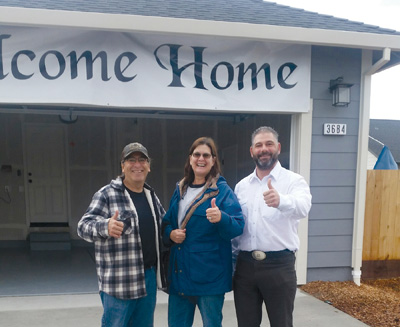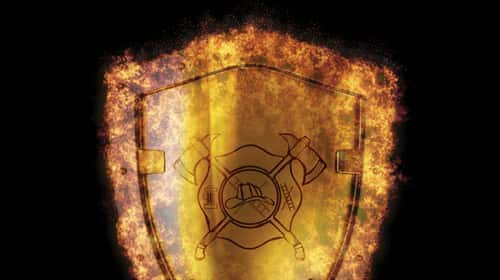As new homes rise in North Bay neighborhoods leveled by fire, it appears life is slowly returning to normal. There is, however, a factor we cannot underestimate: the ever-present risk that comes with living in a fire-prone area. The reality is that fire-resistant houses are essential, but building them will require a shift in thinking, taking into consideration a multitude of factors, such as cost, the availability of materials, various codes, knowledge of best practices and the nature of fire itself.
 Architect David Horobin, of Estudio Verde Architects in Napa, was already conscious of the need for fire-resistant construction when he moved to Wine Country in 2001. Six years before his arrival, he’d rented a house for his family in Los Gatos, but as they were heading to their new home, something seemed amiss. They stopped to find out what was happening and discovered that a fire had broken out. It was the beginning of the Lexington Reservoir fire, a 15,000-acre wildfire in July 1985 that razed their would-be house to its foundation and destroyed 42 more. The blaze inspired Horobin to take an interest in fire-resistant homes, and what he learned led to the house he eventually built for his family in Napa.
Architect David Horobin, of Estudio Verde Architects in Napa, was already conscious of the need for fire-resistant construction when he moved to Wine Country in 2001. Six years before his arrival, he’d rented a house for his family in Los Gatos, but as they were heading to their new home, something seemed amiss. They stopped to find out what was happening and discovered that a fire had broken out. It was the beginning of the Lexington Reservoir fire, a 15,000-acre wildfire in July 1985 that razed their would-be house to its foundation and destroyed 42 more. The blaze inspired Horobin to take an interest in fire-resistant homes, and what he learned led to the house he eventually built for his family in Napa.
“We found a beautiful piece of land in the hills and I set about designing a house that would not burn down,” he says. “I was determined to build a house that was a fortress for my family.” He wanted to make the building as fireproof as possible and had specific ideas. Born in Wales and raised in England, Horobin was familiar with stone-and-brick houses and found it strange that the use of wood was so prevalent in construction in California. He decided on concrete for his own house and designed a home with no wood at all on the outside. He used tempered glass for his doors and windows, as well as fire-resistant shutters and paint, which can reduce fire’s impact on any structure, according to Horobin. “I approached the design of that house from an all-encompassing point of view,” he says. At the time, many people thought it was an eccentric endeavor. But in the wake of a series of firestorms in California, they’ve come to appreciate its efficacy.
Alternative materials
Horobin is a proponent of concrete as a building material, saying that it works well structurally and acoustically, and it’s also extremely energy-efficient if used correctly. To facilitate building with concrete, he developed SmartBlocks, which are foam blocks filled with concrete and rebar. They’re lighter and bigger than conventional concrete blocks. “You stack them up like a big Lego set,” he says. They have a high fire-resistance rating and retain moisture and heat, which increases their strength, so the cement won’t crumble when exposed to high temperatures for an extended period of time. In addition, “You’re basically building a cave,” he points out, so, if designed properly, concrete houses may not require cooling systems in hot weather.
Another alternative to wood is steel, though its use in residential construction in the North Bay is not yet  widespread. Wellington Cellars in Glen Ellen, which produces small-lot, handcrafted wines, used steel for its new building. “We’re seeing more steel construction,” says Joss Hudson, president and founder of EcoSteel, which is based in Laguna Niguel, Calif. and has an office in Santa Rosa. According to Hudson, the use of steel in construction is a slow process because it requires specialized knowledge. Local steel unions and the American Institute of Steel Construction provide training, and as more workers acquire the necessary skills, the use of steel as a construction material for houses is likely to increase.
widespread. Wellington Cellars in Glen Ellen, which produces small-lot, handcrafted wines, used steel for its new building. “We’re seeing more steel construction,” says Joss Hudson, president and founder of EcoSteel, which is based in Laguna Niguel, Calif. and has an office in Santa Rosa. According to Hudson, the use of steel in construction is a slow process because it requires specialized knowledge. Local steel unions and the American Institute of Steel Construction provide training, and as more workers acquire the necessary skills, the use of steel as a construction material for houses is likely to increase.
EcoSteel is a Type 1 construction material, so it has high resistance to fire, up to a point. It will buckle in the ultra-high, sustained temperatures like those the Tubbs Fire produced; however, it’s not combustible, so it doesn’t provide the fuel that allows fire to travel. Among its other advantages, it doesn’t sustain water damage or rot like wood, and it doesn’t attract termites. In addition, much of the steel for construction is recycled, and EcoSteel uses an insulated panel system for walls and roofs, so it’s energy-efficient.
Moving forward
As rebuilding progresses in Napa and Sonoma counties, Horobin sees many houses in the framing stage that are replicas of previous homes made largely of wood, and he finds that disturbing. He says many people don’t think fire will hit them again, so they rebuild the same kind of house. They comply with seismic, structural, energy and acoustic codes, but he perceives a reluctance to embrace new materials and technology. And a lack of information means people often don’t know how to build a fire-resistant home. “It’s a myth that you have to build with wood,” he says, and he encourages people to seek advice and find alternatives.
 John Allen, chief operations officer of APM Homes in Santa Rosa, believes that people are taking the need for fire-resistant homes seriously, but they’re simply overwhelmed. “People are aware, but by the same token, there’s a practicality that goes with it,” he says. His company is working on homes in Coffey Park, offering a choice of building plans, and in Fountaingrove, where APM is constructing custom, one-of-a-kind homes. The options include fire-resistant materials, such as stucco siding and roofs made of composition asphalt shingles, as well as some different design elements. New requirements for attic ventilation, for example, mandate that the holes must be smaller, and fewer people are choosing wooden fences. He points out that it’s nearly impossible to build anything that could withstand an intense blaze like the Tubbs Fire, so defensible space is important to help keep fire from reaching a house, especially in areas such as Fountaingrove and Mark West, which are in the wildland-urban interface, where the risk of fire is greater. APM did extensive tree removal on one lot in Fountaingrove. “It’s basically reducing hazards around the property,” says Allen. He says that while trees and shrubbery against a house or under a deck might be beautiful, landscaping in close proximity to a structure provides a pathway for fire.
John Allen, chief operations officer of APM Homes in Santa Rosa, believes that people are taking the need for fire-resistant homes seriously, but they’re simply overwhelmed. “People are aware, but by the same token, there’s a practicality that goes with it,” he says. His company is working on homes in Coffey Park, offering a choice of building plans, and in Fountaingrove, where APM is constructing custom, one-of-a-kind homes. The options include fire-resistant materials, such as stucco siding and roofs made of composition asphalt shingles, as well as some different design elements. New requirements for attic ventilation, for example, mandate that the holes must be smaller, and fewer people are choosing wooden fences. He points out that it’s nearly impossible to build anything that could withstand an intense blaze like the Tubbs Fire, so defensible space is important to help keep fire from reaching a house, especially in areas such as Fountaingrove and Mark West, which are in the wildland-urban interface, where the risk of fire is greater. APM did extensive tree removal on one lot in Fountaingrove. “It’s basically reducing hazards around the property,” says Allen. He says that while trees and shrubbery against a house or under a deck might be beautiful, landscaping in close proximity to a structure provides a pathway for fire.
The City of Santa Rosa ensures that new construction meets the codes for the wildland-urban interface within its limits. Jesse Oswald, chief building official in the Planning and Development Department, explains that Fountaingrove, for example, is in a high-fire-severity zone, and so it has to meet specific requirements that are more stringent than those for areas at lower risk. Siding, for instance, has to meet a certain standard for fire resistance, and attic and foundation ventilation must mitigate or limit the entrance of embers. Houses must have tempered windows, which are less susceptible to breakage, and roofing must be Class A rated, meaning that it has a high resistance to fire. In addition, the city strongly encourages the use of fire-safe landscaping materials and providing defensible space around structures. “We work with elements to balance the landscaping and beautification,” Oswald explains.
The rebuilding of such a large number of homes is not something the city ever anticipated or planned for, and the process evolves daily. “What we knew five days after the fires and what we know now is completely different,” says Oswald. “We have to be willing and able to change course to facilitate people getting back into their homes,” he adds. He reports that 1,651 homes are in the rebuilding process, and that’s almost two-thirds of the number lost. “Having more than 1,000 homes under construction is unbelievable,” he observes, adding that rebuilding is taking place more quickly than expected.
Even so, many people are facing a deadline since insurance companies put a limit on the amount of time they’ll pay for living expenses. “The time factor is coming into play,” says Allen. The time limit is usually two years, so homeowners are under pressure to get their new houses built before that support ends. To get through the process more efficiently, he suggests turning it over to professionals instead of trying to do it on your own, much like taking a car to a mechanic. “I’m a homebuilder; I do this every day,” he says, recommending that property owners building new homes talk to a contractor who can get permits, draw plans and manage the construction process for them efficiently.
Strategies
As for property in unincorporated areas, the County of Sonoma is responsible. “The county takes rebuilding and fire safety very seriously,” says Maggie Fleming, communications manager for Permit Sonoma, Sonoma County’s land use planning and development permitting agency. Its two guiding principles to prevent future fire loss are hardening structures, which involves modifying construction elements so they are less vulnerable to fires sparked by embers and heat ignition, and decreasing the amount of vegetation around structures. Fleming reports that in 2018, the county allocated $500,000 to support a management and inspection program to help property owners increase the amount of defensible space around their houses. Permit Sonoma also offers education and grant programs to help people apply hardening techniques to existing homes as well as new ones.
and fire safety very seriously,” says Maggie Fleming, communications manager for Permit Sonoma, Sonoma County’s land use planning and development permitting agency. Its two guiding principles to prevent future fire loss are hardening structures, which involves modifying construction elements so they are less vulnerable to fires sparked by embers and heat ignition, and decreasing the amount of vegetation around structures. Fleming reports that in 2018, the county allocated $500,000 to support a management and inspection program to help property owners increase the amount of defensible space around their houses. Permit Sonoma also offers education and grant programs to help people apply hardening techniques to existing homes as well as new ones.
Sonoma County Supervisor James Gore, who oversees District 4, which covers northeast Santa Rosa to the Mendocino County border and includes Coffey Park and Mark West, sees two different approaches to rebuilding. Some property owners are building to current code, which requires features such as fire-resistant wood and interior sprinklers, and others are aiming higher and going beyond the requirements.
 “People are trying to use other materials that are able to withstand fire for four-plus hours,” says Gore. He adds, however, that houses most at risk are 30 to 40 years old, not the ones being rebuilt. “What we learned is that while the fires came from the wildlands, what spread the fires wasn’t the trees, it was the houses themselves. The houses were fuel,” he says. He doesn’t find it surprising that the Tubbs Fire burned through Mark West, Larkfield and Wikiup because those are vulnerable rural areas. The real eye-opener was that it destroyed whole neighborhoods in Santa Rosa, like Coffey Park. After it jumped Highway 101, it traveled from one home to another as a result of heavy, intense burning from the houses themselves, he explains, and that makes it important to fortify existing homes, as well as rebuilds. “If perimeter houses are hardened, it will help those in the middle,” he says, calling it communal-benefit hardening.
“People are trying to use other materials that are able to withstand fire for four-plus hours,” says Gore. He adds, however, that houses most at risk are 30 to 40 years old, not the ones being rebuilt. “What we learned is that while the fires came from the wildlands, what spread the fires wasn’t the trees, it was the houses themselves. The houses were fuel,” he says. He doesn’t find it surprising that the Tubbs Fire burned through Mark West, Larkfield and Wikiup because those are vulnerable rural areas. The real eye-opener was that it destroyed whole neighborhoods in Santa Rosa, like Coffey Park. After it jumped Highway 101, it traveled from one home to another as a result of heavy, intense burning from the houses themselves, he explains, and that makes it important to fortify existing homes, as well as rebuilds. “If perimeter houses are hardened, it will help those in the middle,” he says, calling it communal-benefit hardening.
The Sonoma County Energy Independence Program offers PACE—property assessed clean energy—a program that enables financing for improvements to homes and commercial buildings. Though it started with enhancements such as solar panels and green roofing, the state opened PACE to include home hardening in 2018. “They made the legislative change needed to do that,” Gore explains. The change allows homeowners to borrow money from YGrene, a private company with an office in Petaluma that developed a new system of financing so property owners can make infrastructure improvements and pay them back through their property taxes. “This is a huge opportunity to leverage home hardening throughout the state,” adds Gore. He anticipates that a grant to the county from FEMA will subsidize homeowners, but he says, “The only way to make an impact is if people in fire country sign up.”
Opportunities
Rebuilding a house similar to what they had before gives people a certain amount of comfort, but with insurance companies settling claims for less than expected, they often have to think creatively. Horobin has clients who are empty nesters, and with a smaller budget than they anticipated, they went from 2,000 square-feet to 1,500 after realizing their lifestyle had changed, and they didn’t need so much space or the same kind of house. “It’s a golden opportunity to do something new,” he says, adding that a new house can be more energy-efficient and sustainable if made of the right materials. And in addition, “We can make it so the fricking thing doesn’t burn down next time.”
Meanwhile in Butte County, after the Camp Fire of 2018, the residents of Paradise are grappling with the challenge of rebuilding an entire town. In February, Horobin attended a meeting, where major stakeholders assembled with a representative of the California Insurance Commissioner’s office to ask questions and discuss the issues. Horobin says that insurance companies in general have been unwilling to provide coverage for houses in Paradise for 10 years because of the fire risk. Without changes they aren’t going to insure those that are rebuilt, either. The solution is having everyone work together, starting with attorney Robert Kennedy Jr., who is doing pro bono work to negotiate the best settlements with insurance companies. Next, Horobin will collaborate with the town council and building department to meet their needs and design fire-resistant homes. His plan is to provide several designs for houses that will have concrete roofs, concrete walls and steel shutters with fire-resistant paint that will give people choices and fit their budgets. Homeowners who still prefer wood can paint it with a fire-protective material. Insurance companies will see the designs before construction begins to make sure the houses meet their requirements, and an insurance policy will be part of the package. “If you can build a home that isn’t going to burn down, the insurance companies are going to look at you,” says Horobin.
Teamwork is also a factor in Sonoma County, where block captains in burned-out areas provide strength in numbers. Gore explains that early on, town halls were emotional and chaotic, and supervisors launched the program to create order. “In the first six months, it was all reactive,” he says. But since then, block captains have engaged in activities such as meeting with professionals to get an education on the various aspects of building, holding weekly meetings to share resources and providing information to their neighbors. “It has been the most inspiring thing I’ve been part of,” says Gore, who sees the block captains’ efforts as empowering the community through the community.
It’s a challenging time, and as rebuilding continues, Horobin encourages people to think about what they want. “It affords them an opportunity that they might never have again in their lives—if they’re ready to dream,” he says. And he points out that if a home is fire-resistant, it provides another, intangible benefit. “Peace of mind is something that most people don’t think about,” he says. But once that’s achieved, it’s priceless.
The Insurance Dilemma
Insurance companies are increasingly reluctant to take the risk of providing coverage for new homes in high-severity fire zones, and that complicates rebuilding for property owners who need mortgages to cover the shortfall between insurance payouts and constructions costs. A house is collateral, so lenders require insurance. A last resort for California residents is California Fair Plan Property Insurance, which is based in Los Angeles. It was created in 1968, following brush fires and riots in the 1960s, for people who were unable to obtain insurance in the voluntary insurance market.
www.cfpnet.com
Resilient City
The Tubbs Fire destroyed approximately 3,000 structures in Santa Rosa, and they were primarily single-family residences. The status of rebuilding is as follows:
• 168 houses completed and occupied
• 1,033 under construction
• 183 have had permits issued but not started construction
• 334 in the planning and review process
To learn more about rebuilding in Santa Rosa, visit the Resilient City website: srcity.org/2675/Rebuilding
Building construction types
Type 1: Fire resistive
Usually high-rises that are constructed of concrete and protected steel and coated with a fire-resistant material, normally concrete.
Type 2: Non-combustible
Typically new buildings with walls and roofs constructed of non-combustible materials. Walls are commonly reinforced with masonry or tilt slab (concrete), while roofs have metal structural member and decking.
Type 3: Ordinary
New or old buildings with non-combustible walls and a wooden roof. Older buildings might have unreinforced masonry and a conventionally framed roof, while newer buildings have lightweight roof systems supported by reinforced masonry or tilt slab.
Type 4: Heavy timber
Buildings with large lumber for the structure and interior elements. Most buildings were built before 1960, and bolts and metal plates were used as connectors.
Type 5: Wood-framed
Found in most modern homes. The walls and roof are made of combustible materials, usually wood. Roofing is most often ceramic tile or asphalt shingles over wooden trusses.
Source: www.firerescuemagazine.com





